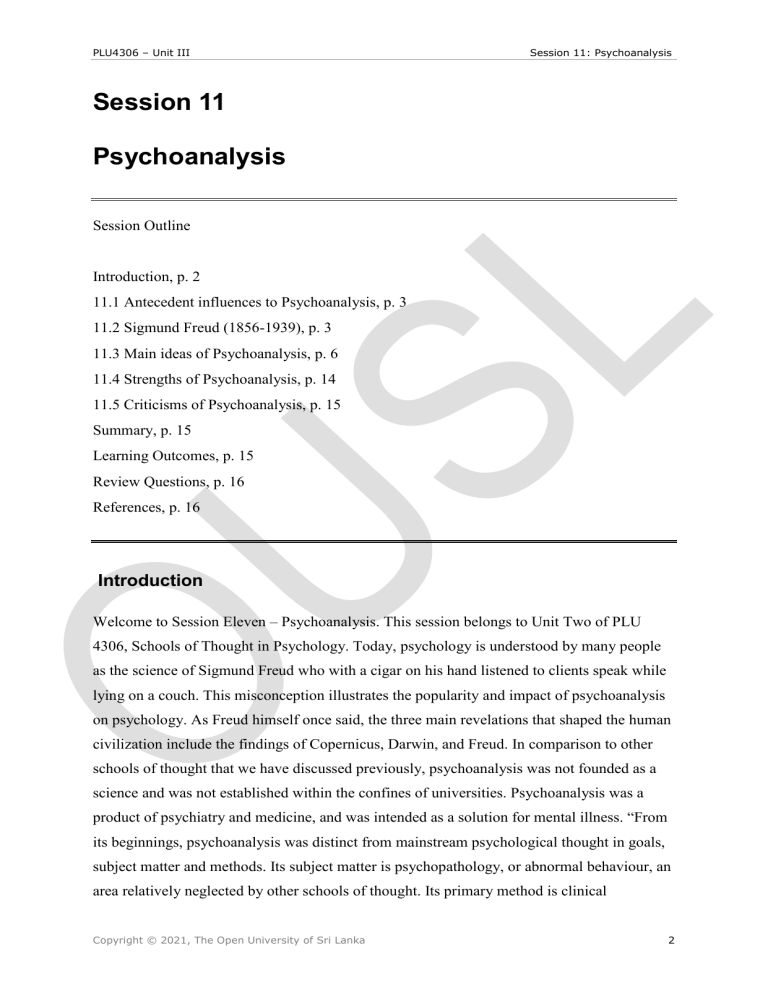
PLU4306 – Unit III Session 11: Psychoanalysis Session 11 Psychoanalysis Session Outline Introduction, p. 2 11.1 Antecedent influences to Psychoanalysis, p. 3 11.2 Sigmund Freud (1856-1939), p. 3 11.3 Main ideas of Psychoanalysis, p. 6 11.4 Strengths of Psychoanalysis, p. 14 11.5 Criticisms of Psychoanalysis, p. 15 Summary, p. 15 Learning Outcomes, p. 15 Review Questions, p. 16 References, p. 16 Introduction Welcome to Session Eleven – Psychoanalysis. This session belongs to Unit Two of PLU 4306, Schools of Thought in Psychology. Today, psychology is understood by many people as the science of Sigmund Freud who with a cigar on his hand listened to clients speak while lying on a couch. This misconception illustrates the popularity and impact of psychoanalysis on psychology. As Freud himself once said, the three main revelations that shaped the human civilization include the findings of Copernicus, Darwin, and Freud. In comparison to other schools of thought that we have discussed previously, psychoanalysis was not founded as a science and was not established within the confines of universities. Psychoanalysis was a product of psychiatry and medicine, and was intended as a solution for mental illness. “From its beginnings, psychoanalysis was distinct from mainstream psychological thought in goals, subject matter and methods. Its subject matter is psychopathology, or abnormal behaviour, an area relatively neglected by other schools of thought. Its primary method is clinical Copyright © 2021, The Open University of Sri Lanka 2 PLU4306 – Unit III Session 11: Psychoanalysis observation rather than controlled laboratory experimentation. And psychoanalysis deals with the unconscious, a topic virtually ignored by other systems of thought” (Schultz & Schultz, 2004). 11.1 Antecedent influences to Psychoanalysis Even though psychoanalysis was Sigmund Freud’s theory, many of his concepts were borrowed from conceptions of the mind that already existed during his time. The main contributors to Psychoanalysis were the theories of the unconscious mind, the work of Charles Darwin and contemporary research and knowledge on psychopathology. Theories of the unconscious mind were first prominent by the early 18th century philosopher Gottfried Wilhelm Leibnitz, through his Theory of Monadology (Schultz & Schultz, 2004). Leibnitz defined a monad as a physical entity similar to an atom, but mental in nature. Thus, a monad is similar to a perception. He believed that monads had different levels of consciousness. Lesser degrees of consciousness were called petites perceptions and the conscious acknowledgement of these entities was known as apperception. Almost a century later, Leibnitz’s ideas were reformed by Johann Friedrich Herbart who argued that ideas below a specific threshold of consciousness would be ‘unconscious’. An idea is perceived only when it rises to the level of consciousness. For an idea to rise to this level, however, it must be compatible with ideas that already occupy the conscious level of the mind. The next intellectual whose ideas are consistent with Freud’s is Fechner. He suggested that the mind is like an iceberg. With increased discussion on the topic of the unconscious in the academic circles, it soon become one of the most interesting topic of interest. 11.2 Sigmund Freud (1856-1939) Sigmund Freud, commonly known as the father of psychoanalysis, was born in then Moravia. As the eldest of a very large family, Freud was immensely adored and loved by his mother and these sentiments seemed to have been reciprocated. Freud both loved and feared his father, because of his authoritarian nature. One of Freud’s later theories, known as the ‘Oedipus Complex’, was derived out of this love for his mother and fear for his father. The autobiographical nature of the presented theories is one of the reasons scholars criticize psychoanalysis. Copyright © 2021, The Open University of Sri Lanka 3 PLU4306 – Unit III Session 11: Psychoanalysis Image 11.1: Young Freud and his Father Source: https://upload.wikimedia.org/wikipedia/commons/5/58/Sigmund_Freud_as_a_child_with_his _father.jpg Moving to Vienna around the age of four, provided the educational background that Freud received. It is at the University of Vienna, as a medical student, that was exposed to Darwin’s theory of evolution, philosophy, and the use of cocaine. After opening a private practice Freud married Martha Bernays, with whom he had six children. Young Freud became acquainted with the physician Josef Breuer who at times acted as a father figure to him. The two physicians regularly discussed their patients with one another, and it is during such a conversation that the case of Anna O was discussion. This case was instrumental in the founding of Psychoanalysis. “Anna O suffered from severe hysterical complaints including paralysis, memory loss. The symptoms first appeared when she was nursing her dying father, who had always pampered her. It was said that she felt for him a kind of passionate love” (Schultz & Schultz, 2004). Breuer treated Anna through hypnosis. Under a hypnotic trance, Breuer instructed Anna to relive the disturbing experience of nursing her dying father. This experience seemed to reduce her symptoms. But with time, Anna developed a condition clinically known as ‘transference’ today. Transference is the process by which the client begins to consider the Copyright © 2021, The Open University of Sri Lanka 4 PLU4306 – Unit III Session 11: Psychoanalysis therapist as a significant person (a parent or lover) in the client’s life. In the case of Anna, she transferred the love she felt for her father to Breuer and because of this emotional attachment Breuer eventually stopped treating Anna. Anna’s case is important to the development of psychoanalysis because it introduced Freud to the cathartic method or the talking cure. In 1885, Freud had the opportunity to work with Charcot for a brief period of time. It is during this time that Freud was initially exposed to the idea that sexual base caused hysterical behaviour. Upon his return from Vienna Freud became dissatisfied with hypnosis as a therapeutic technique and instead developed the technique of ‘free association’. This new method required patients to lie on a couch and speak whatever came to his or her mind, without interference from the therapist. During the session, no eye contact was maintained between client and therapist. The therapist then attempted to piece together clients’ statements in an attempt to interpret the underlying dynamics that caused the free associations. Image 11.2: Sigmund Freud Source: https://pixabay.com/photos/sigmund-freud-doctor-neurologist-400399/ With the information he uncovered from clients using free association, Freud claimed that “his patients revealed childhood seductions, with the seducer usually an older relative, often the father. Freud asserted that these seduction traumas were the cause of adult neurotic behaviour” (Schultz & Schultz, 2004). In his final years, Freud suffered enormously due to a mouth cancer and subsequent surgeries. With Hitler gaining power, Psychoanalysis was declared as an unholy approach to Copyright © 2021, The Open University of Sri Lanka 5 PLU4306 – Unit III Session 11: Psychoanalysis understanding human behaviour and even amidst much dislike, Freud had to move to England where in 1939 he requested his physician to put him to rest by an overdose of morphine because he was unable to bear the growing pain from his cancer. 11.3 The main ideas of Psychoanalysis Levels of consciousness – the topographical model Image 11.3: Structural Iceberg Source: https://upload.wikimedia.org/wikipedia/commons/b/be/Structural-Iceberg.svg Freud divided the personality into three main parts as the unconscious, preconscious and the conscious. This is known as the topographical model. The thoughts that you are currently aware of at a given moment are known as the ‘consciousnesses. “This material changes constantly as new thoughts enter your mind and pass out of awareness” (Burger, 2011). As illustrated on the figure, what we are consciously aware is only the tip of the iceberg. Most of our personality lies below our level of consciousness. It is possible to bring thoughts to consciousness if one wanted to, “this large body of retrievable information makes up the preconscious” (Burger, 2011). For example ‘what did you have for dinner last night? What is the name of your neighbour? Psychoanalytically speaking, what is most useful and what occupies the biggest portion of the mind is the unconscious. “This is material to which you have no immediate access. According to Freud, you cannot bring unconscious thoughts into consciousness except under Copyright © 2021, The Open University of Sri Lanka 6 PLU4306 – Unit III Session 11: Psychoanalysis certain extreme situations. Nonetheless, this unconscious material is responsible for much of your everyday behaviour” (Burger, 2011). Oedipus and Electra complexes Named after the Greek legend of Oedipus, Freud described the Oedipus complex as “the unconscious desire of a boy of 4 or 5 years for his mother and the desire to replace or destroy his father” (Schultz & Schultz, 2004). You can find out more about Oedipus through this link: https://www.greekmythology.com/Myths/Mortals/Oedipus/oedipus.html The father is unconsciously viewed as a threat to the boy’s desire for his mother. According to Freud children of this age usually develop sexual attraction towards parents of the opposite sex and begin to perceive the same sex parent as a threat. With a boy, this is known as the Oedipus complex and with a girl this is known as the Electra complex. One must also keep in mind that most of the theoretical aspects proposed by Freud. The structure of the mind In addition to the topographical model of the mind, Freud proposed the structural model of the mind consisting of three components known as id, ego and super- ego. Consider the following scenario, Amith is sitting in the classroom listening to a lecture when he starts to feel hungry. Suddenly one part of his mind says “open your lunchbox and eat at this very moment”, where as another part would say “no, no if you do so you will be punished by the teacher. This is against the rules”. Finally Amith compromise between the two thoughts and waits for five minutes till the lunch break and has his lunch. In this scenario, the part of one’s mind driven by selfish and primal desires is known as the id. At the time of birth, till the age of two, a child’s mind only consists of id impulses. According to Freud, the id is driven by the pleasure principle and requires instant gratification. As shown in Figure 3, the id is believed to reside completely in the unconscious. A person with an overpowering id, tends to be driven by basic primal instincts. In Amith’s example the second voice that stood for what is right and wrong is known as the super ego. This component is driven by the morality principle and begins to develop after 5 Copyright © 2021, The Open University of Sri Lanka 7 PLU4306 – Unit III Session 11: Psychoanalysis years of age. “The superego represents society’s and, in particular, the parent’s values and standards. The super ego places more restrictions on what we can and cannot do” (Burger, 2011). If a person breaks the moral code then the super ego will attack the person with guilt. People with weak super egos tend to have less restrain in doing socially deviant acts such as stealing. People with too strong a super ego, on the other hand, would have impossible moral standards and would strive for perfection. The part of the mind that compromises between the id and the super ego is known as the ego. Driven by the reality principle, develops from two years of age. The ego tries to satisfy the id impulses in a manner that is acceptable to the super ego (social standards). Inability to find a balance between the id and super ego, results in anxiety and stress. In a healthy individual, a strong ego controls the interactions between the id and the super ego. Activity 11.1 Identify the dominant structure of the mind for the following scenarios – id, ego or superego A baby who is hungry crying until he/she was fed When a friend invites you to a birthday party a day before a job interview, you decide not to attend it thinking that there will be more parties and that the interview is more important. After you work hard on your homework, your friend asks you for your answers. You tell her that she may have the answers, but only if she promises to do her own homework next time. You really love lollipops. You see a small child holding a lollipop in the street. You grab it and run away. You see a person getting bullied and calls the law authority to handle the problem. Instinct theory Freud believed that all our behaviours are governed by psychic forces known as instincts. Basically there are two instincts: the life instinct (Eros) and the death instinct (Thanatos).Eros is a life and pleasure enhancing force which is considered to be sexual in nature. The sexual drive is not only applicable to erotic actions but to any action seeking to gain pleasure. Thanatos is one’s desire to return to the stability of inorganic matter. The death instinct can be expressed internally (self-destruction) or externally (aggression towards others). Anxiety With the id, ego and superego pulling one’s mind in three different directions, the ego begins Copyright © 2021, The Open University of Sri Lanka 8 PLU4306 – Unit III Session 11: Psychoanalysis to experience much anxiety, which may be divided into three types object anxiety, neurotic anxiety and moral anxiety. Defense Mechanisms According to Freud, when faced with anxiety, in order to prevent our mind being overwhelmed with anxiety, ego employs variety of defense mechanisms. Table 11.1: Different defense mechanisms (Gross, 2009) Defense mechanism Description Repression Displacement Denial Example Forcing a distressing memory out of A five year old repressing consciousness and making it its incestuous desire for the unconscious. opposite sex parent. Transferring feelings from the true Frustration caused by target onto a harmless, substitute problems at work expressed target. as domestic violence. Refusing to acknowledge some Refusing to accept that your aspect of reality. partner has broken up with you. Rationalization Finding an acceptable excuse for In the Aesop’s fable, the fox some really quite unacceptable decides he did not want the behaviour grapes because they were sour, when in reality he was unable to reach them high on the vine Reaction formation Consciously feeling the opposite of Going out of your way to be one’s true feelings. nice to someone you truly dislike. Sublimation A form of displacement in which a Playing sport to redirect socially acceptable activity is found aggressive urges. for expressing some unacceptable impulse. Projection Displacing your own unacceptable ‘I hate you’ become ‘you feelings onto someone else. hate me’ Copyright © 2021, The Open University of Sri Lanka 9 PLU4306 – Unit III Regression Session 11: Psychoanalysis Reverting to behaviour The elder child trying to characteristic of an earlier stage of imitate the behaviours of the development. younger sibling to get attention. Activity 11.2 Find the matching defense mechanism used in the following scenarios. 1. Thilina is a shop owner and a thief. At his store, he automatically accuses of stealing anyone who looks suspicious. This is an example of what defense mechanism? Repression Reaction Formation Denial Projection Sublimation 2. Karen decides to go out and party the whole week before her midterm exams instead of studying. She fails her midterm, and tells her parents that she failed it because she was sick and was not getting enough sleep. This is an example of what defense mechanism? Rationalization Sublimation Denial Repression Reaction Formation 3. Instead of taking out his anger on others, Saman plays the saxophone when he gets really angry. This is an example of what defense mechanism? Repression Sublimation Denial Reaction Formation Projection 4. Nethmi blocks her bad memories of high school bullies from her mind. This is an example of what defense mechanism? Denial Reaction Formation Copyright © 2021, The Open University of Sri Lanka 10 PLU4306 – Unit III Session 11: Psychoanalysis Projection Repression Sublimation 5. Aravinda’s favourite uncle passes away after a long battle with illness, but he refuses to believe that it happened. This is an example of what defense mechanism? Denial Reaction Formation Sublimation Repression Projection 6. Gihani is angry with Manel, but eventually she becomes friends and is nice to him. This is an example of what defense mechanism? Reaction Formation Denial Rationalization Sublimation Projection (Psyc. Defense Mechanisms, n.d.) Psychosexual stages Freud believed that the adult personality is heavily influenced by the first few years of a child’s life. Thus, he believed that each child progresses through a series of developmental stages known as psychosexual stages. Each stage is characterized by a primary erogenous zone. “Freud maintained that children face specific challenges as they pass through each stage and that small amounts of psychic energy are used up resolving these challenges. ….some children have a difficult time moving through a particular stage (or for a few, find a stage excessively satisfying and wish to remain there). The result is referred to as a fixation, the tying up of psychic energy… the adult is said to express behaviours characteristic of the stage at which the energy is fixated” (Burger, 2011). The psychosexual stages are as follows, 1. Oral stage – (birth till 18 months of age). The primary source of pleasure or the erogenous zone for the stage is centered on the mouth, lips and the tongue. The main reason for this is that at this stage the child derives pleasure from sucking at the mother’s breast. If the Copyright © 2021, The Open University of Sri Lanka 11 PLU4306 – Unit III Session 11: Psychoanalysis child has problems succeeding this stage, he/she will develop an oral personality where as adults they will smoke, drink excessively and bite his or her nails. Image 11.4: Oral stage Source: https://www.maxpixel.net/Breast-feeding-Motherhood-The-Birth-Of-Mother-Child1582978 2. The anal stage – (1 to 3 years of age). This is the stage when parents toilet train the children. Thus the erogenous zone is the anal region. Excessive gratification in this stage leads to messiness, sloppiness and unregulated self-expression. In the other extreme results in orderliness, stinginess and obstinacy. Image 11.5: Toilet training child Source: https://pixabay.com/photos/child-sitting-potty-training-316211/ 3. The phallic stage – (3 to 6 years of age). In this stage children derive pleasure from Copyright © 2021, The Open University of Sri Lanka 12 PLU4306 – Unit III Session 11: Psychoanalysis manipulating their genitals. They show curiosity about their own and other’s bodies. It is at this stage that certain individuals develop Oedipus and Electra complexes. Image 11.6: Phallic stage Source: https://www.maxpixel.net/Nature-Soap-Bubbles-Kids-Daughter-Summer-Baby-Dad3369549 4. The latency stage – (6 and puberty). Sexual and libidal impulses are repressed at this stage. Impulses are redirected through school work and hobbies. Children seems to be uninterested in their opposite sex peers at this stage. Image 11.6: Peer interaction Source: https://en.wikipedia.org/wiki/Attachment_theory#/media/File:Children_marbles.jpg 5. Genital stage – (after puberty) Initiated with puberty the children will now look to separate from the parents and develop a relationship with a person of the opposite sex. Copyright © 2021, The Open University of Sri Lanka 13 PLU4306 – Unit III Session 11: Psychoanalysis Image 11.7: Genital stage Source: https://pixabay.com/photos/couple-love-feelings-seaside-2300099/ Dream analysis Freud considered dreams to be the “royal road to the unconscious”. Freud’s most famous publication on this subject is the 1990 publication of ‘The Interpretation of Dreams’. Freud believed that dreams were manifestations of unfulfilled unconscious desires. According to him, every dream has two levels: the manifest content and the latent content. Freudian Slip The typical slips of the tongue are where a person supposedly by accident says something inappropriate or wrong. For example, a women may accidently call her husband by her father’s name. According to Freud, these slips do not occur coincidentally, but rather due to some unconscious desire. 11.4 Strengths of Psychoanalysis Even though most of the psychoanalytic theories were not experimental in nature, they paved way for future experimental endeavors. Although highly criticized, psychoanalytic theories still influence Psychology to such an extent that still the world recognized psychology only in terms of Freud’s contribution. Psychoanalysis offered two novel insights to the study of the mind and treating mental illnesses. The first of which is the idea of the unconscious, instincts, childhood experiences. Hence psychoanalysis introduced the notion that trauma at an early age can cause a lifetime Copyright © 2021, The Open University of Sri Lanka 14 PLU4306 – Unit III Session 11: Psychoanalysis of problems. This has meant that children’s emotional needs important to address. The second insight is that talking about problems with a professional can help relieve symptoms. This has positively contributed to increase the reputation of psychotherapy in the general community. 11.5 Criticisms of Psychoanalysis Freud is criticized for the over emphasis placed on the contribution of the unconscious, sexual desires and childhood experiences. For him almost all the problems stemmed from those three reasons. Furthermore the concepts proposed by psychoanalytic theorists are not empirically validated and considered unscientific because most of the theories are autobiographically derived from Freud’s own life experiences. Summary Sigmund Freud was the founder of psychoanalysis and the psychodynamic approach to psychology. This school of thought emphasized the influence of the unconscious mind on behaviour. Freud’s theories on the topographical and structural levels of the mind, dream analysis, psychosexual stages are still influential in therapy and teaching. Much of these theories have been derived from Freud’s own work and is criticized for the lack of scientific validity. But without doubt Freud can be considered as the most influential theorist in Psychology. Learning Outcomes At the end of the session, students should be able to: Locate the background to Psychoanalysis Explore Freud’s contribution to psychology Examine the main principles of Psychoanalysis Revise the strengths and weaknesses of the psychoanalytic school of psychology Copyright © 2021, The Open University of Sri Lanka 15 PLU4306 – Unit III Session 11: Psychoanalysis Review Questions 1. What are the factors that lead to the founding of the psychoanalytic school of thought? ………………………………………………………………………………………………… ………………………………………………………………………………………………… ………………………………………………………………………………………………… ………………………………………………………………………………………………… ………………………………….……………………………………………………………… 2. Identify the main theoretical principles forwarded by Sigmund Freud on the mind and human development ………………………………………………………………………………………………… ………………………………………………………………………………………………… ………………………………………………………………………………………………… ………………………………………………………………………………………………… ……………………………………….………………………………………………………… 3. What are strengths and limitations of the psychoanalytical school of thought? ………………………………………………………………………………………………… ………………………………………………………………………………………………… ………………………………………………………………………………………………… ………………………………………………………………………………………………… ………………………………………………………………………………………………… References Burger, J. (2011). Introduction to Personality (8th ed.). Canada: Wadsworth Cengage Learning. Gross, R. (2009). Psychology : the science of mind and behaviour. London: Hodder Arnold. Psyc. Defense Mechanisms. (n.d.). Retrieved from ProProfs Quiz Maker: https://www.proprofs.com/quiz-school/story.php?title=practice-psy-exam-1 Schultz, D., & Schultz, S. (2004). A History of Modern Psychoology (8 ed.). Thomson/Wadsworth. Copyright © 2021, The Open University of Sri Lanka 16
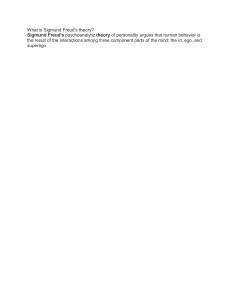
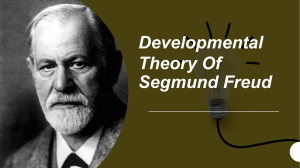

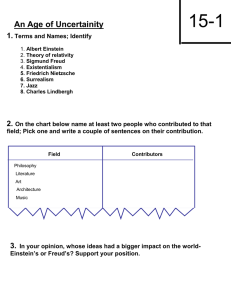
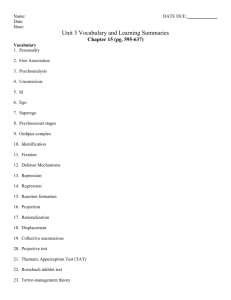

![Freud[1]](http://s3.studylib.net/store/data/009188810_1-b4da58acda3597f24583464fef8dd596-300x300.png)